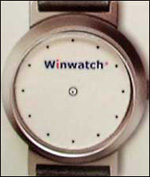Jul 13, 2004Last year, Switzerland produced nearly 25 million wristwatches, with a total value of 9.29 billions Swiss francs (US$7.57). Swiss brands such as Cartier, Longines, Piaget and Rolex are often counterfeited. A Swiss startup has patented a way of embedding a tiny RFID transponder in the glass crystal of a watch as a way of preventing counterfeiting and enabling consumer application.
Winwatch has teamed up with Hitachi Europe and will use Hitachi's tiny µ-chip (pronounced mu-chip) to track watches. The µ-chip is just 0.4 mm x 0.4 mm and has a tiny antenna etched into the surface of the microchip, making it a fully functioning transponder that stores a 128-bit serial number. Winwatch says Hitachi will provide its "µ-chip solution information management system," but declined to provide details about that system, citing a nondisclosure agreement with Hitachi.
Winwatch is also working with a Swiss company called Hexalog, which sells customized software products for small and midsize companies. Hexalog provides medical applications, as well as real-time data acquisition systems. Hexalog will integrate Winwatch's solution into its customized software for clients.
The µ-chip operates at 2.45 GHz and uses a numbering system developed by Hitachi. So each chip contains a unique serial number that can be associated with a particular watch. When that watch is shipped to a retailer, the retailer can confirm that the watch is authentic by checking the serial number with the watch’s manufacturer.
Because of the small size of its antenna, the RFID transponder can be read only if it is no more than 1 mm (.04 inch) from the antenna of an RFID reader. But there are benefits to putting the chip in the glass watch crystal. It means the watch designers do not have to change the internal watch components to add an RFID tag, and it is easier to read the transponder in the crystal because there is no interference from metal or from the body of the person wearing the watch.
So far, no Swiss watch companies have signed deals to use the technology, but Alex Kalbermatten, CEO and cofounder of Winwatch, says he is in discussions with a number of manufacturers. "We're beginning to team up with Swiss watchmakers, and our vision will become reality very soon," he says. "It’s just a matter of a short time before we see the first interactive Swiss-made wristwatches with RFID tags embedded in the watch glass."
In addition to preventing counterfeiting, Winwatch hopes that RFID transponders in watches can be used for personal identification, access control, loyalty cards and electronic payments. "In a couple of years, we envision joint ventures between the Swiss watch industry and other companies, such as car manufacturers," says Kalbermatten. "You might, for instance, use your Breitling watch to unlock the door of your Bentley car."
The numbering system that uses Hitatchi for the µ-chip is proprietary, so companies wanting to use Winwatch's technology for such applications would need to adopt the same proprietary system. As manufacturers of standards-based RFID transponders shrink their chips to the size of the µ-chip, ISO- or EPC-based transponders could be embedded in watches. That could open up broader applications, such as using the watch for payments in stores or tracking purchases as part of opt-in loyalty programs.
Attend RFID Journal
University
There are only two weeks left until RFID Journal University in New York City. This unbiased educational course, presented by RFID Journal and members of Auto-ID Labs, is designed to provide the in-depth understanding of RFID and EPC technologies needed to evaluate vendors and begin planning a successful implementation. Register today, or to see complete course outlines, visit RFID U.


